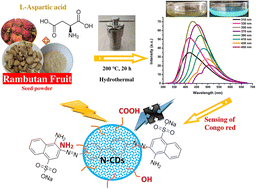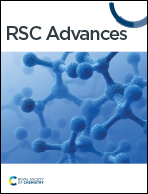Rambutan seed waste-derived nitrogen-doped carbon dots with l-aspartic acid for the sensing of Congo red dye
Abstract
In this study, new nitrogen-doped carbon dots (N-CDs) were prepared by utilizing rambutan seed waste and L-aspartic acid as dual precursors (carbon and nitrogen sources) through a hydrothermal treatment method. The N-CDs showed blue emission in solution under UV light irradiation. Their optical and physicochemical properties were examined via UV-vis, TEM, FTIR spectroscopy, SEM, DSC, DTA, TGA, XRD, XPS, Raman spectroscopy, and zeta potential analyses. They showed a strong emission peak at 435 nm and excitation-dependent emission behavior with strong electronic transitions of C![[double bond, length as m-dash]](https://www.rsc.org/images/entities/char_e001.gif) C/C
C/C![[double bond, length as m-dash]](https://www.rsc.org/images/entities/char_e001.gif) O bonds. The N-CDs exhibited high water dispersibility and great optical properties in response to some environmental conditions such as heating temperature, light irradiation, ionic strength, and storage time. They have an average size of 3.07 nm and good thermal stability. Owing to their great properties, they have been used as a fluorescent sensor for Congo red dye. The N-CDs selectively and sensitively detected Congo red dye with a detection limit of 0.035 μM. Moreover, the N-CDs were utilized to detect Congo red in tap and lake water samples. Thus, rambutan seed waste was successfully converted into N-CDs and these functional nanomaterials are promising for use in important applications.
O bonds. The N-CDs exhibited high water dispersibility and great optical properties in response to some environmental conditions such as heating temperature, light irradiation, ionic strength, and storage time. They have an average size of 3.07 nm and good thermal stability. Owing to their great properties, they have been used as a fluorescent sensor for Congo red dye. The N-CDs selectively and sensitively detected Congo red dye with a detection limit of 0.035 μM. Moreover, the N-CDs were utilized to detect Congo red in tap and lake water samples. Thus, rambutan seed waste was successfully converted into N-CDs and these functional nanomaterials are promising for use in important applications.



 Please wait while we load your content...
Please wait while we load your content...